The Lincoln cent was first struck in 1909. Its obverse portrait of the sixteenth president, designed by Victor David Brenner and bulldozed through the Mint bureaucracy by President Theodore Roosevelt, is the nation’s oldest circulating coin design. With over a billion pennies minted annually, this portrait is the world’s most frequently reproduced work of public art. One can find it in any gutter.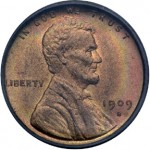
Nearly 225 years after the first Independence Day, we still call the cent, our smallest copper coin, after a British coin, the penny, which dates back over two thousand years. In the third century B.C., the Romans first coined the denarius, their standard silver coin, which was about the size of our dime. It was probably the coin handed to Jesus of Nazareth when he was asked whether paying taxes to Caesar was lawful; thirty of them were the blood money paid Judas Iscariot.
The emperors gradually debased the denarius, alloying its silver with ever-larger proportions of copper until no silver remained. After the Legions withdrew from Britain in the fifth century A.D., British kings struck crude imitations of the denarius, which invading Angles and Saxons called “penning” or “pfennig.” Hence, penny.
The North American British colonies used English money—pounds, shillings and pence—yet they lacked small change. Some places used wampum, Native American money made from beads. Connecticut made corn legal tender at two shillings a bushel and New York at five shillings a bushel. Congress made nails legal tender by size, which is why some are still called three-penny nails. The most common coins were Spanish milled dollars, the famous “pieces of eight” (so called because their value in Spanish money was eight reales). The Americans, logically, valued a reale at 12½ cents (the old jingle, “Shave and a haircut, two bits,” refers to a 25¢ visit to the tonsorial parlor).
The federal government was too broke to strike its own coins; small change was a chaos of state and foreign coins, and merchants’ advertising tokens. The Continental Congress and the colonies had financed the Revolution with oceans of heavily discounted paper money. A horse worth 80 Spanish dollars cost $2,500 in paper money. Nor were the colonies’ monies at par with one another: one New Hampshire shilling was worth nearly five-and-a-half South Carolina shillings.
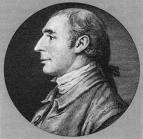 In 1782, Gouverneur Morris wrote a report describing the “perplexing…and troublesome” exchange rates among state currencies. He suggested a federal mint and a national coinage that would reconcile the different state currencies with an extremely complicated system involving a common denominator of 1,440 units.
In 1782, Gouverneur Morris wrote a report describing the “perplexing…and troublesome” exchange rates among state currencies. He suggested a federal mint and a national coinage that would reconcile the different state currencies with an extremely complicated system involving a common denominator of 1,440 units.
Perhaps only two men in the United States understood what Morris had in mind. The other man, Thomas Jefferson, had a better idea. In July 1784, he published an article in The Providence Gazette and Country Journal stating the obvious: Morris’s scheme would prove enormously cumbersome in day-to-day business. Jefferson proposed a decimal system: “The most easy ratio of multiplication and division is that by ten. Everyone knows the facility of Decimal Arithmetic.” He suggested using the dollar, divided into dimes (even today the coin worth one-tenth of a dollar is denominated “one dime,” not “ten cents”), and copper coins worth one one-hundredth of a dollar, which became the cent. Finally, in April 1792, Congress established the U.S. Mint, which struck the first copper one-cent pieces in 1793. From the beginning, the public called them pennies.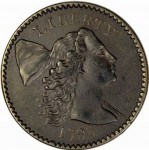
 The first cents were larger than today’s quarters. They were unpopular and expensive to produce. From 1850, the Mint experimented with possible replacements. In 1857 the Mint struck the first small cents, bearing a flying eagle. Two years later, Liberty appeared on the penny, wearing an Indian war bonnet. The model was no Indian:
The first cents were larger than today’s quarters. They were unpopular and expensive to produce. From 1850, the Mint experimented with possible replacements. In 1857 the Mint struck the first small cents, bearing a flying eagle. Two years later, Liberty appeared on the penny, wearing an Indian war bonnet. The model was no Indian: the designer, James Longacre, apparently popped an Indian headdress on his pretty daughter Sara. But charming Sara was merely a model for an allegory. Placing an historical person on a coin was seen as monarchical and inappropriate for a republic. This suited the Mint bureaucracy, who seemed more concerned about whether their coins would stack for easy counting than their physical beauty.
the designer, James Longacre, apparently popped an Indian headdress on his pretty daughter Sara. But charming Sara was merely a model for an allegory. Placing an historical person on a coin was seen as monarchical and inappropriate for a republic. This suited the Mint bureaucracy, who seemed more concerned about whether their coins would stack for easy counting than their physical beauty.
At the beginning of the 20th century, Charles Barber had been chief engraver of the Mint for nearly a generation. Barber was competent without the slightest spark of creativity. His masterpieces were the so-called Barber dime, quarter and half dollar, first minted in 1892. The three designs were virtually identical, distinguished only by size and denomination. However, they were easy to mint and stacked well.
In 1905 Theodore Roosevelt dined with Augustus Saint-Gaudens, whose sculpture the President admired. Behind the Rough Rider wielding the Big Stick was a naturalist, man of letters, and aesthete, who took as strong an interest in public art as any president since Jefferson. The conversation drifted to the beauty of ancient Greek coins, which Saint-Gaudens described as almost the only ones of real artistic merit. The President, asking why the United States could not have coins as beautiful, challenged the artist: if Saint-Gaudens would design them, Roosevelt would mint them.
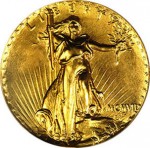 The sculptor and the statesman collaborated to make coins beautiful. Their triumph is Saint-Gaudens’ “Standing Liberty” twenty-dollar gold piece, first struck in 1907. On the obverse, a voluptuous Liberty holds aloft in her right hand the torch of Enlightenment and in her left the olive
The sculptor and the statesman collaborated to make coins beautiful. Their triumph is Saint-Gaudens’ “Standing Liberty” twenty-dollar gold piece, first struck in 1907. On the obverse, a voluptuous Liberty holds aloft in her right hand the torch of Enlightenment and in her left the olive 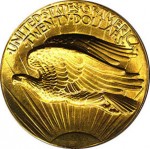 branch of peace. On the reverse, an eagle soars above a sun rising in glory. Saint-Gaudens died before he could design a new cent. Roosevelt had another artist for the job.
branch of peace. On the reverse, an eagle soars above a sun rising in glory. Saint-Gaudens died before he could design a new cent. Roosevelt had another artist for the job.
Victor David Brenner (1871-1924) was born in Lithuania on June 12, 1871. His father, an artisan, taught him engraving and jewelry-making in his shop (Father also carved gravestones). He also saw that Victor was instructed in history, languages, and the Talmud. In 1890, Brenner arrived in New York, and worked as a die cutter while attending Cooper Union, the Art Students League, and the National Academy of Design. Five years later, he began executing art medals for the American Numismatic Society. In 1898, he began three years’ work and study in Paris, where he won a bronze medal at the 1900 Paris Exposition.
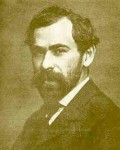 In 1908, Brenner was commissioned to create a bronze plaque for the centennial of Lincoln’s birth in 1909. Around the same time, the Panama Canal Commission also retained him to design a medal. Its obverse would bear President Roosevelt’s profile. T.R. posed at Brenner’s studio. The President openly admired the plaster patterns for the Lincoln plaque and later suggested to his secretary of the treasury that Brenner’s portrait of Lincoln should appear on a coin. Consequently, Brenner was the only person invited to participate in formulating the new design, much to the chagrin of Charles Barber.
In 1908, Brenner was commissioned to create a bronze plaque for the centennial of Lincoln’s birth in 1909. Around the same time, the Panama Canal Commission also retained him to design a medal. Its obverse would bear President Roosevelt’s profile. T.R. posed at Brenner’s studio. The President openly admired the plaster patterns for the Lincoln plaque and later suggested to his secretary of the treasury that Brenner’s portrait of Lincoln should appear on a coin. Consequently, Brenner was the only person invited to participate in formulating the new design, much to the chagrin of Charles Barber.
Brenner’s constraints were set by law. A one-cent piece was 19 millimeters in diameter and weighed 3.11 grams. It would be struck on bronze planchets, blank discs of copper alloyed with tin. The design had to include a date and mintmark; the words “Liberty,” “In God We Trust,” “E Pluribus Unum” and “The United States of America”; as well as the denomination, “One Cent.” The design also had to prove simultaneously easy to strike, long-wearing in circulation, and appealing to the eye.
The coin’s obverse replicates the centennial plaque’s bust. However, Brenner’s challenge in designing a penny was the relief, the relationship of the coin’s features to its field, the flat surface of the coin. When a coin executed in bas-relief (with the features extending above the field) is circulated, the design’s high points show the most wear. Brenner executed the cent in lower relief than the plaque, sacrificing depth and detail to meet coin production requirements and extend its circulating life.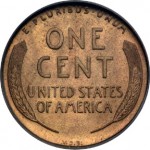
Brenner’s design for the reverse was brilliantly successful. The words are rendered in a slender Gothic font inspired by the Vienna Secession, and two stylized ears of durum wheat enwreath the denomination. Though the obverse is traditional, the reverse is late art nouveau, perhaps with a strong flavor of art deco. At the bottom, Brenner placed his initials, V.D.B.
He created three-dimensional plaster models, twelve inches in diameter, of the coin’s obverse and reverse, with the relief in proportion to the finished coin’s. Once approved, the model was thinly plated with copper and placed on a pantographic reduction lathe. This machine’s tracing tool transferred the details in miniature into a soft steel blank, the master hub, which was then heat-treated, or annealed, to harden it and then used to make the master dies from which the working dies are made.
The planchets were mechanically fed into the coin presses, which struck each planchet with three dies in a cold-strike process. A feeder placed the planchet on the lower or anvil die; a ram then forced the upper die against the planchet. The pressure compressed the metal, which flowed outward against the collar, which in turn forced it back into the cavities of the upper and lower dies. This took a fraction of a second.
The Lincoln cent was first issued on August 2, 1909. Crowds swarmed the Sub-treasury in Wall Street to purchase them. Three days later, however, coin production was halted due to a media-created controversy over Brenner’s initials on the reverse. Barber gleefully ground the initials entirely off the master dies. In 1918, after Barber’s death, Brenner’s initials were quietly placed on the lower edge of the truncation of Lincoln’s bust.
Brenner’s reputation soared. He executed hundreds of tablets, commemorative medallions and prize medals. His work is in the New York Public Library, the Brooklyn Museum, the Metropolitan Museum of Art, the Musee d’Orsay, the Boston Museum of Fine Arts and the Smithsonian. He is considered the most capable designer, engraver, and cutter of medals in his time. He arrived in New York a tradesman; his industry and determination transformed talent into genius.
However, none can foresee the enduring power of mediocrity. In 1959, to commemorate the 150th anniversary of the birth of Lincoln, the Mint replaced Brenner’s simple reverse with a bland rendition of the Lincoln Memorial. The design was created in-house; no outside submissions were considered. Some compare it to a bus or a trolley car.
After 230 years, the penny, now struck on lightweight copper-plated zinc planchets, lives on borrowed time. Its major constituency, the zinc industry, helps keep it alive through its support of a lobby, Americans for Common Cents. Their strongest argument against its abolition is that all prices would then rise to the next five-cent increment. No politician wants that responsibility.
The penny is now only the small change required by state sales taxes. Once it was part of the blood-money of God.
New York Press, May 15, 2001